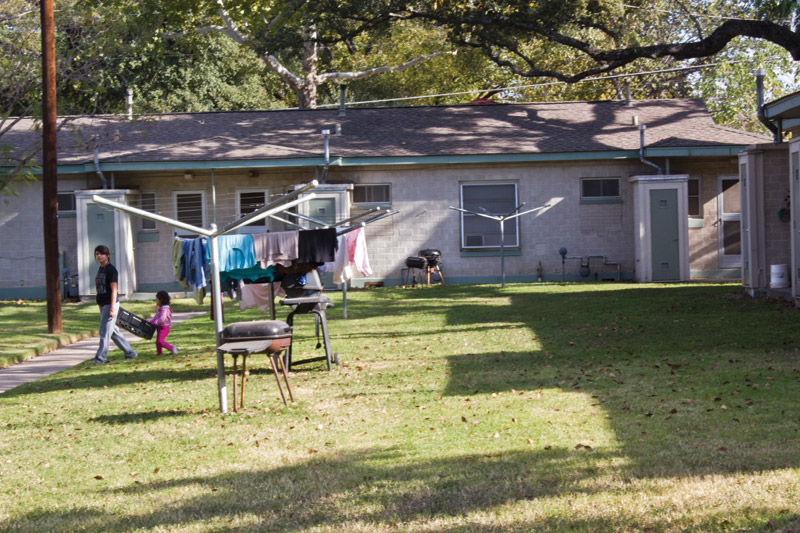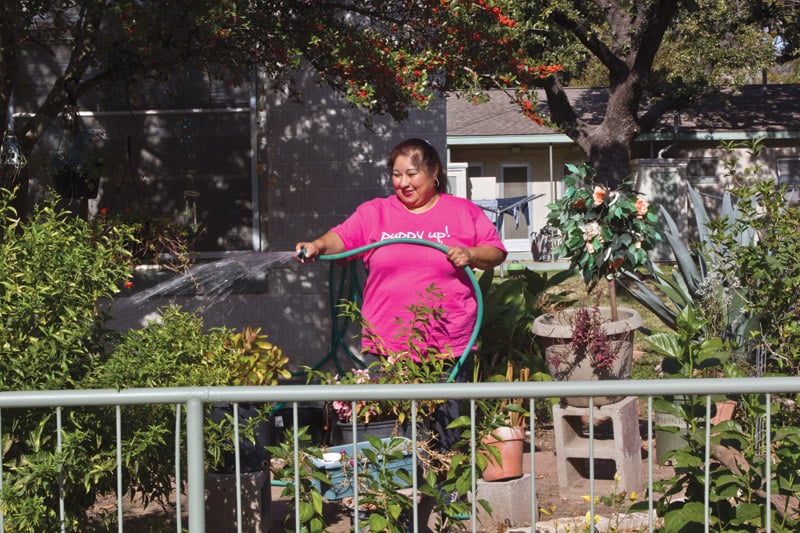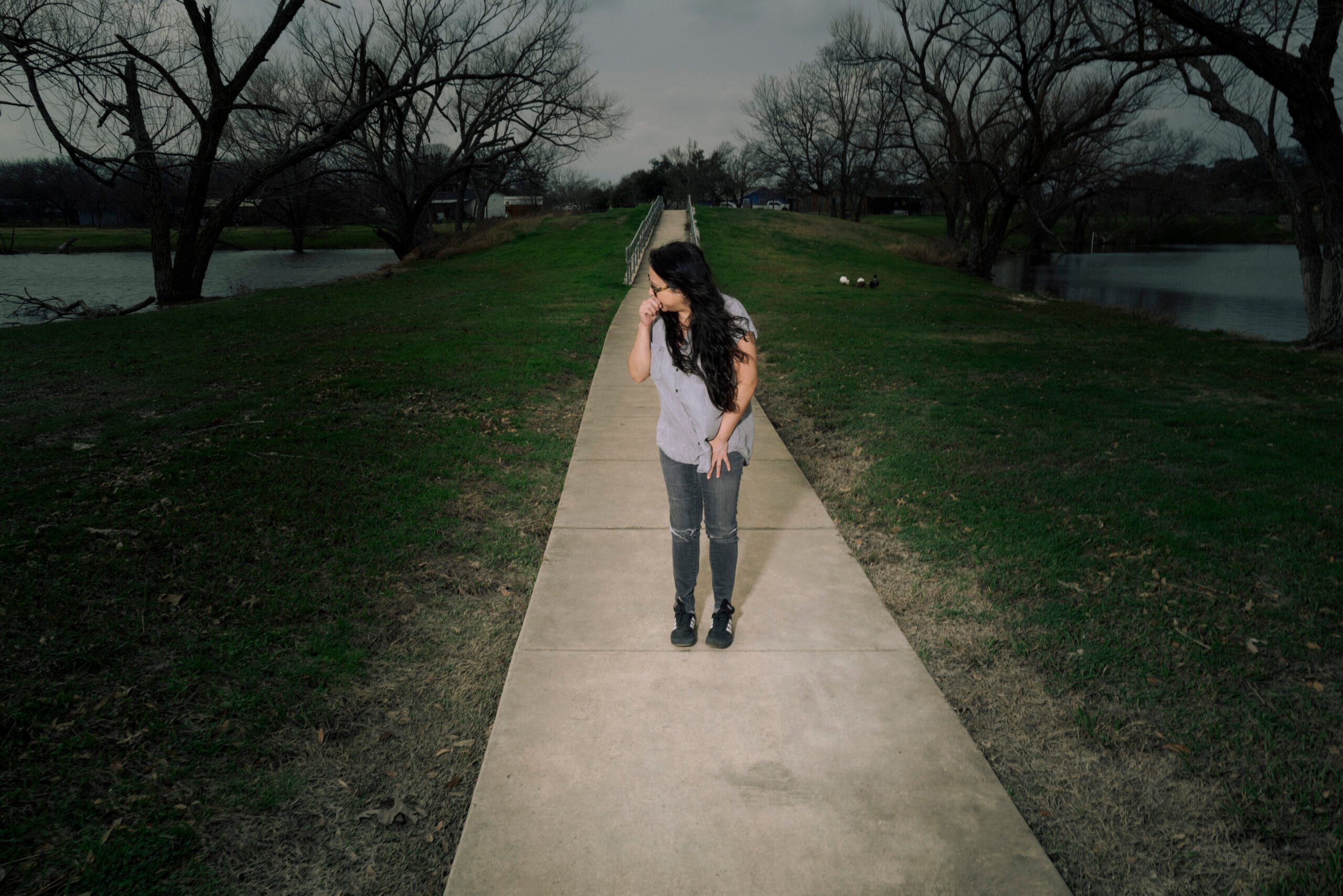
Santa Rita Courts and the Fight for Affordable Public Housing
Public housing is no less political an issue now than it was in the 1930s.
A version of this story ran in the December 2012 issue.
Above: Santa Rita Courts in Austin
Elaine Sandoval is standing in the late-afternoon sun watering the towering plants outside her apartment at East Austin’s Santa Rita Courts housing project.
“It started off with a pine tree,” she says. “My boyfriend did it. He was a landscaper. So he started putting them in.
“When he passed away a few years ago,” she says, sweeping her arm in a grand arc around the yard and chuckling, “he left me all this.”
While many of Santa Rita’s gray cinder-block units are adorned with flowers here or a small tree there, no garden is quite as varied and enveloping as Sandoval’s.
“You’ll see on this side it’s a lot of desert plants,” she says, “because he was from El Paso. So he was like, ‘this side will be my side, and this side is your side.’”
Across the short walkway dividing the yard, red and yellow flowers lean on the fence. There’s rosemary and honeysuckle, giving the garden a sweet smell.
To Sandoval, the garden has become something more than just the legacy of a loved one. “I started seeing that it makes your house look warm,” she says. “Even though we live in the projects, we don’t have to act like it.”

Sandoval has lived in her unit at Santa Rita Courts since 2000. It’s convenient, she says, with easy access to transit, her family (who live in the neighborhood) and essentials like the nearby HEB supermarket. As a mother who worked nights while raising four daughters, Sandoval says she found it hard to make ends meet without subsidized housing.
Today, her daughters grown, she still has her hands full with work, caring for her elderly aunt and watching her grandchildren. Because she doesn’t drive, she says, living in a close-in urban neighborhood is a definite advantage.
Javier Amador, who lives on the other side of the project on Santa Rita Street, also relies on Santa Rita’s location. As we chat in front of his apartment, the Frost Bank Tower and other downtown landmarks are visible in the distance.
Amador, 62, is on a fixed income due to disability, and has lived at Santa Rita for about seven years. “I enjoy it here,” he says. “There’s a place right down the road, I’m going to say a quarter mile—the Conley-Guerrero Senior Activity Center. I go there a lot. I also pay my electric bill and go grocery shopping right down the street. I like it.”
While Santa Rita residents like Sandoval and Amador enjoy the benefits of low-cost urban living, the number of people needing affordable housing in Austin has very much outpaced the city’s supply.
The Department of Housing and Urban Development considers a tenant or homeowner “cost-burdened” if the person pays more than 30 percent of his or her income on housing costs. Studies cited in the Imagine Austin Comprehensive Plan suggest that over half of Austin tenants fall into this category, up from 42 percent in 2000.
Most severely affected are those with very low incomes. A 2009 study conducted by the City of Austin Neighborhood Housing and Community Development department found that the Austin area has 44,700 renters earning less than $20,000 a year. These residents had just 7,150 affordable units in the city from which to choose, a six-to-one ratio of renters to available units, translating to a 37,000-unit shortfall.
Patricia Campbell, a public affairs officer with HUD, says the increase in demand for affordable housing is an issue throughout the country.
“Overall, I can say that nationally, because of the economic situation we’ve been in, there has been an increase in demand,” she says. “The other factor is that those who currently have vouchers and public housing have not been moving out. They have been holding onto their housing because of economics, so turnover has been slower, which further decreases the number of units.”
The increasing need for affordable housing is readily apparent in Texas. Studies by the National Low Income Housing Coalition show that in 2011, a person making minimum wage in Texas had to work an 88-hour week to afford an average fair-market-value two-bedroom apartment without being cost-burdened. It’s not just minimum wage-earners who are having trouble, either. Studies show that in Texas’ major cities, only about half of available jobs provide earnings sufficient to afford the average market-rate apartment.
These statistics mark a turnaround for Texas, one of the country’s most affordable states as recently as the turn of the century. It’s also an ironic situation for Austin, a city that pioneered modern affordable housing.
Santa Rita Courts boasted a long list of firsts when it was completed in June 1939. It was the first affordable housing project in the nation to receive allocations from the newly created United States Housing Authority (which eventually became HUD), the first to be completed and the first to be occupied.
Behind the groundbreaking development was a young, ambitious Lyndon Baines Johnson, who in 1937 had been elected to his first term in the U.S. House of Representatives.
Johnson ran on the New Deal platform and largely had minority and low-income voters to thank for his election. After entering Congress, he was instrumental in passage of the 1937 U.S. Housing Act, which would create the United States Housing Authority (USHA) and enable creation of Santa Rita Courts.
Contemporary photos in the Austin American-Statesman detailing the opening of Santa Rita show Johnson on one knee, his silk-lined suit coat draped over his shoulder, posing with, as the paper put it, “five Mexican children whose smiles record half a dozen national records achieved by him for Austin.” It was Johnson’s first major political achievement, and the first act of a career spent supporting federal housing initiatives.
It was not an easy victory. The fight over public housing had been raging in Congress in the years before Johnson took office. By the time it was passed into law, the Housing Act had been through three different versions stretching back to 1935. Compromises in the law included concessions to Southern congressmen requiring that each project created by the USHA be segregated. This move finally garnered enough support to pass the bill, creating the USHA and making federal funds available for the development.
As Johnson was about to discover, however, the battle wasn’t over. There was very vocal local opposition to the idea of federal housing for the poor.
“It was a hard sell,” says Danny Camacho, an expert on East Austin history who volunteers at the Austin History Center. “A very hard sell.” Supporters of federal housing developments ran newspaper ads promoting the idea of social responsibility, but the public also heard from opponents, including many of Austin’s powerful realtors. “You had this group saying you should be self-reliant,” Camacho says. “People saying, ‘why should I stop what I’m doing, create agencies, pay tax dollars, so you can live in an affordable house?’”
A few weeks after the creation of the Austin Housing Authority, Johnson took to the radio to make his case. His “Tarnish on the Violet Crown” speech, delivered Jan. 23, 1938, on Austin’s KNOW radio, painted a lurid picture of East Austin’s “slums” and lashed out at those who opposed the construction of housing projects there.
“Yes sir, it is true,” Johnson said in the address, “the government is competing with the shacks and hovels and hog sties and all the other foul holes in which the underprivileged have had to live. If you object to that kind of government competition, then I’m disappointed in you.”
It was a sharp jab at Austin’s landlords, many of whom opposed such housing developments because they thought federally subsidized construction would compete with their business. Though stipulations that government housing projects would not compete with private landlords had been part of the passage of the Housing Act, landlords were still wary of Johnson’s proposals, believing them “socialistic.”
It took more than a speech to address these critics. Displaying the stubbornness and persuasiveness that would become a hallmark of his political career, Johnson met with the city’s realtors to defend his plan. It was a rowdy gathering. Johnson singled out individual landlords who opposed his plan and accused them of being slumlords, going so far as to identify the number of substandard units they operated. He and the Austin Housing Authority had come armed with statistics and maps highlighting the city’s slum problem.
Johnson claimed that of the 1,700 houses then in East Austin, as many as 1,000 were substandard. He cited statistics showing that 27 percent of units in Austin were overcrowded, 10 percent above the average for American cities.
Johnson would soon get his way. The city of Austin received 186 units of public housing—40 for Hispanic residents at Santa Rita Courts; 60 at Rosewood Courts, the black development; and 86 at Chalmers Courts, reserved for white tenants. It was the beginning of the modern era of affordable housing, and the first major victory in Johnson’s long political career.
Santa Rita’s creation had clear benefits for poor Hispanic families on Austin’s East Side. Before the availability of federally subsidized housing, low-income families were at the mercy of the private market. In Austin, and in many other Texas cities, this usually amounted to poorly appointed one-room shacks. Newspaper articles of the time tell graphic stories about large families crammed into these small spaces, battling challenges from mosquito infestation to outbreaks of tuberculosis. City- or county-run refuges such as poor houses and asylums were the only other options, but space in these was severely limited and often unavailable to minorities.
Santa Rita’s units were clean and well-equipped, with gas ranges, indoor plumbing, and other amenities rarely available to low-income renters at the time. All this was available for $10 a month—about the same, or less than, tenants had paid to live in their former quarters.
However, the immediate improvement in architectural and sanitary conditions hardly created an ideal situation. The developments were segregated per the 1937 Housing Act, isolating Hispanic and black residents deep in the East Side, separate from the rest of the city.
The order to desegregate Santa Rita and Rosewood Courts, along with the rest of Austin’s public housing, would not come until 1967, and actual desegregation did not occur until later still. This separation mirrored a larger dynamic of isolation for minorities and low-income groups in often-neglected parts of America’s cities. It also helped contribute to the decline of America’s inner cities in the 1980s and 1990s—a decline that would take a hard toll on places like East Austin.
Residents of Santa Rita and the surrounding neighborhood are frank about the area’s problems during this era. Camacho, who has lived just a few blocks from Santa Rita Courts since the 1960s, recalls witnessing drug deals at the development from the bus stop on 2nd Street.
Robberies were common, and sometimes resulted in assaults and even deaths. It wasn’t just Santa Rita, however. “On the whole, the East Side had drug issues,” Camacho says.
Sandoval, who occupied a unit at Santa Rita for a brief time in the late 1980s and early 1990s, also recalls it being “much wilder” then. She remembers a time when members from two rival gangs would have brawls and even shootouts in Santa Rita.
Sandoval says Santa Rita is a different place now. “It’s calmed down since the ’90s,” she says. “It’s quiet. My neighbor is an elderly man, and my other neighbor works a lot. I can let my granddaughter go play on the other side [of the Courts].”
Residents like Sandoval and Amador feel attached to the Santa Rita community. “I wouldn’t want to move—my roots are grown,” she says. “That’s what I feel now. My grandkids need me here. I love being right here. You have your ups and downs, but that’s anywhere.”
Public housing is no less political an issue now than it was in the 1930s. With budget-cutting the perennial promise of many campaigns, government housing programs often find themselves on the chopping block. The idea of zeroing out federal housing was even an issue in this year’s race for the White House. On the campaign trail, Republican presidential hopeful Mitt Romney remarked he would consider eliminating HUD altogether if he became president.
And in Austin, Proposition 15, which would have awarded $78 million to organizations like Habitat for Humanity to build more affordable housing, failed on the November ballot.
Today, the Housing Authority of the City of Austin (HACA) administers nearly 2,000 units of affordable housing in 19 projects around Austin, and distributes vouchers for another 5,000 through Section 8, a federal program started in the 1970s to bring affordable housing and the private rental market together through funds provided by HUD.
Despite the work of HACA and other agencies, the shortage of affordable places to live, especially in the central city, is getting more severe. Recent studies by the City of Austin’s Neighborhood Housing and Community Development department show many low-income residents have been forced to seek housing outside the city, further from employment, government services, and social centers in areas where transportation options are more limited.
The studies suggest that by 2020, an additional 12,500 rental units priced at $425 per month or less will have to be developed to meet the growing number of low-income renters. Such an expansion would keep affordable-housing availability at its current level, not address the shortage that already exists. In the meantime, the benefits of living close to the city’s center now enjoyed by Sandoval, Amador, and their neighbors are becoming increasingly hard to attain for people of low and moderate income.
Asked about the future of affordable housing in Austin, Danny Camacho is clear-eyed but not cynical. The housing projects of the 1930s and 1940s were no panacea for low-income folks, he suggests, but they have been part of an ongoing and worthy effort—one that started in Texas with LBJ and Santa Rita Courts.
“There will always be a need not just for affordable housing, but for [government-built housing] like Santa Rita,” he says. “It’s just one way of addressing things. Every generation has to address, in whatever manner they can, these issues. And I don’t see the sense of success being, ‘this will never happen again, we finally solved it.’ You’re never going to find a solution to life … but it shouldn’t discourage you, make you think we should just forget it.”


